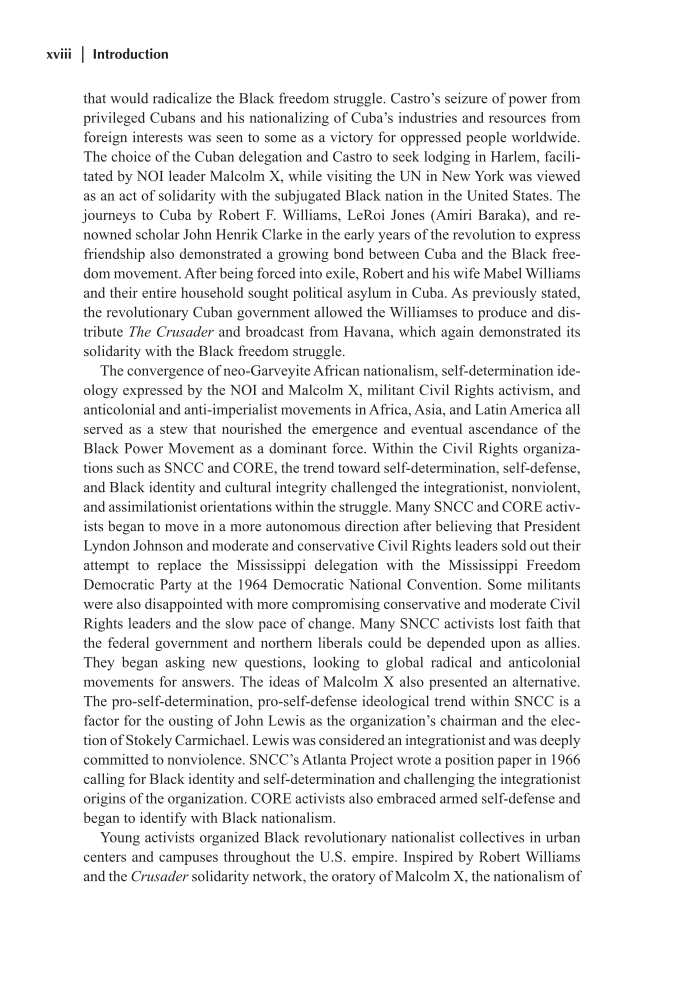xviii | Introduction that would radicalize the Black freedom struggle. Castro’s seizure of power from privileged Cubans and his nationalizing of Cuba’s industries and resources from foreign interests was seen to some as a victory for oppressed people worldwide. The choice of the Cuban delegation and Castro to seek lodging in Harlem, facili- tated by NOI leader Malcolm X, while visiting the UN in New York was viewed as an act of solidarity with the subjugated Black nation in the United States. The journeys to Cuba by Robert F. Williams, LeRoi Jones (Amiri Baraka), and re- nowned scholar John Henrik Clarke in the early years of the revolution to express friendship also demonstrated a growing bond between Cuba and the Black free- dom movement. After being forced into exile, Robert and his wife Mabel Williams and their entire household sought political asylum in Cuba. As previously stated, the revolutionary Cuban government allowed the Williamses to produce and dis- tribute The Crusader and broadcast from Havana, which again demonstrated its solidarity with the Black freedom struggle. The convergence of neo-Garveyite African nationalism, self-determination ide- ology expressed by the NOI and Malcolm X, militant Civil Rights activism, and anticolonial and anti-imperialist movements in Africa, Asia, and Latin America all served as a stew that nourished the emergence and eventual ascendance of the Black Power Movement as a dominant force. Within the Civil Rights organiza- tions such as SNCC and CORE, the trend toward self-determination, self-defense, and Black identity and cultural integrity challenged the integrationist, nonviolent, and assimilationist orientations within the struggle. Many SNCC and CORE activ- ists began to move in a more autonomous direction after believing that President Lyndon Johnson and moderate and conservative Civil Rights leaders sold out their attempt to replace the Mississippi delegation with the Mississippi Freedom Democratic Party at the 1964 Democratic National Convention. Some militants were also disappointed with more compromising conservative and moderate Civil Rights leaders and the slow pace of change. Many SNCC activists lost faith that the federal government and northern liberals could be depended upon as allies. They began asking new questions, looking to global radical and anticolonial movements for answers. The ideas of Malcolm X also presented an alternative. The pro-self-determination, pro-self-defense ideological trend within SNCC is a factor for the ousting of John Lewis as the organization’s chairman and the elec- tion of Stokely Carmichael. Lewis was considered an integrationist and was deeply committed to nonviolence. SNCC’s Atlanta Project wrote a position paper in 1966 calling for Black identity and self-determination and challenging the integrationist origins of the organization. CORE activists also embraced armed self-defense and began to identify with Black nationalism. Young activists organized Black revolutionary nationalist collectives in urban centers and campuses throughout the U.S. empire. Inspired by Robert Williams and the Crusader solidarity network, the oratory of Malcolm X, the nationalism of
Document Details My Account Print multiple pages
Print
You have printed 0 times in the last 24 hours.
Your print count will reset on at .
You may print 0 more time(s) before then.
You may print a maximum of 0 pages at a time.




























































































































































































































































































































































































































































































































































































































































































































































































































































































































































































































































































